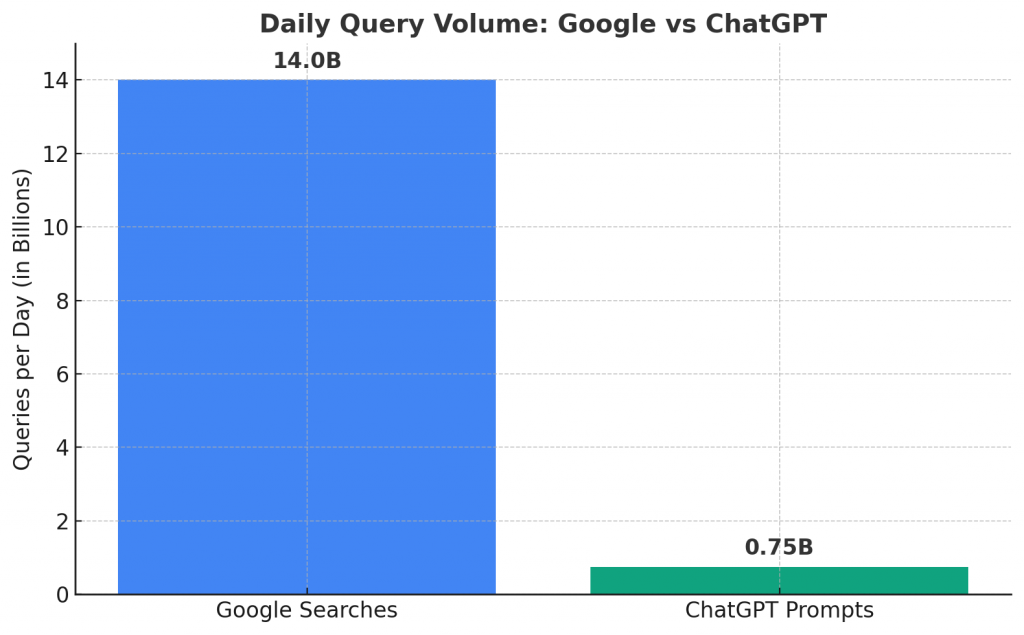The SEO world is facing its biggest shake-up in decades. As chatbots and AI-powered assistants like ChatGPT, Gemini, Perplexity, and Claude increasingly serve as primary sources of information, a new term has entered the digital marketing vocabulary: Generative Engine Optimisation (GEO).
GEO refers to the process of optimising your website or content to appear in the answers provided by generative AI tools – those that respond to user prompts with synthesised, often citation-free responses instead of a list of clickable links. Just as brands once fought for the top spot on Google’s first page, they are now seeking visibility in the outputs of AI chatbots.
So, are brands wasting their time optimising for GEO or is it on pace to become the most popular traffic source for some businesses? In short – this channel is relatively small, but growing quickly. Most importantly it’s used by a lot of decision makers so businesses, and especially B2B ones, should already be trying to optimise for GEO.
Generative search is big and growing quickly but what is the actual data telling us?
Google processes over 14 billion searches per day and that is a massive increase compared to the last time we got any estimate from them. At the same time usage of chatbots and other generative AI tools is climbing fast. As if February OpenAI’s ChatGPT had over 400 million monthly active users, and according to a recent scoop by Axios, ChatGPT users send more than 2.5 billion prompts each day globally.
While that growth is really impressive, can we really compare a search and a chat prompt apples for apples?
According to a recent SparkToro article and data from SEMRush only about 30% of all prompts can be qualified as “replacements of traditional search activity”. The rest are activities that can’t be done via a traditional search engine – things like generating images, summarising text and “vibe coding“.
This makes a lot of sense, after all is a user going to go to ChatGPT if the simply want to visit another website, buy something online or check the weather? A large proportion of all of the chatbot usage falls in the informational type of searches on Google.

Assuming that a prompt means a new message (not a new thread) we can estimate that the largest search engine has 20 times more daily traffic than the most popular chatbot. This is a massive difference comparable to Google’s market share vs all other search engines combined.

So the question is – if all other search engines made a change that required businesses to shift their optimisation strategies, would they bother? Probably not.
That, however, is not the whole story. Google itself is pivoting. With its Search Generative Experience (SGE) and AI Overviews, Google is placing ML-generated summaries above traditional results often reducing visibility and traffic to the pages it draws from.
The trend is clear: Generative answers are now ubiquitous, and we can expect their usage to continue growing.
Market share is not the only thing businesses need to consider when deciding if they need to invest in a channel. The number of eyeballs is important, but event more critical is who these eyeballs belong to.
Who is using GEO?
Despite the already impressive numbers (2.5 billion prompts per day in ChatGPT alone) it’s clear that GEO is still in its early adopter phase with 34% of U.S. adults reporting that they have ever used ChatGPT.
The same study by Pew Research estimates that 18-29 and 30-49 year olds have been the most prolific users of the platform and overall usage has doubled since 2023. In this group adults with higher levels of formal education stand out as the most frequent users.
This broadly tracks with my experience and ad hoc observations – most of the smartest young professionals around me have integrated at least one of the AI chat bots in their workflows and are using heavily for research, summarisation and as part of their decision-making.
So in short – if your business’s ideal customer profile or user is a Millennial with bachelor degree you should make sure that you understand how their usage of AI tools interfaces with your business and position yourself in this channel.
As most marketers know pay-to-play is the easiest and fastest (albeit not the cheapest) way to get in front of the right audience. So what is the state of paid GEO?
Is paid GEO coming? Soon but not yet
Monetisation of these AI platforms is still evolving. There are some experiments with paid brand placements and sponsored citations but these are in their infancy. I’ll tackle that in a future article, when we have more concrete updates.
One thing most users and businesses can be certain of is that all of the major AI companies are looking at paid advertising. Google and Facebook’s quarterly earnings looks very appealing to these guys and they will try and get a piece of that pie.
In the next article of this series I’ll focus on what you can do to appear organically in generative outputs.
Stay tuned for that and follow me on LinkedIn if you want to know when that piece comes out.